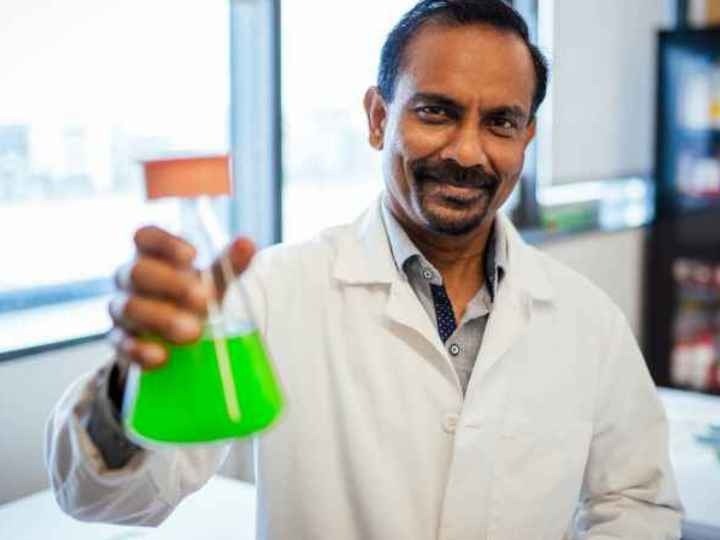Research on algae from the University of Houston (UH) could be about to take scientists one major step closer to the goal of having net-zero carbon emissions. Major algae investigations at the UH at Sugar Land Microbial Products Lab are unlocking hidden possibilities.
 Venkatesh Balan holds a flask of cyanobacteria. Its bright green color is a sign of its ability to convert sunlight into energy. But more intriguing for Balan and his team of researchers is cyanobacteria’s untapped power to capture carbon dioxide from the atmosphere. Image Credit: University of Houston
Venkatesh Balan holds a flask of cyanobacteria. Its bright green color is a sign of its ability to convert sunlight into energy. But more intriguing for Balan and his team of researchers is cyanobacteria’s untapped power to capture carbon dioxide from the atmosphere. Image Credit: University of Houston
A study detailing the research endeavor was published in the Royal Society of Chemistry journal Green Chemistry.
Venkatesh Balan, an associate professor of engineering technology in the Division of Technology at the Cullen College of Engineering at the University of Hawaii, is investigating peculiar characteristics of microalgae, which are small, light-sensitive, phototropic organisms found in both fresh and salt water.
Microalgae can absorb carbon dioxide (CO2) from the atmosphere. However, what most intrigues Balan and his research team is how it can use several processes to transform the CO2 it has captured into mass-produced proteins, lipids, and carbohydrates.
This green process goes beyond climate issues. For example, it may even transform the way we produce our food.
Venkatesh Balan, Associate Professor, Engineering Technology, Cullen College of Engineering, University of Houston
His study assesses the viability of producing food, fertilizers, fuels, and chemicals from algal biomass and treating wastewater with microalgae. Supplements and cosmetics contain algae, including spirulina, that are cultivated in freshwater environments. Microalgae have the potential to serve as a sustainable feedstock in the future, enabling the production of biofuels and biochemicals that could reduce reliance on fossil fuels.
The most immediate superpower of microalgae, though, is its potential to be a major player in the solution to global warming.
Balan added, “We are experiencing climate change. This summer’s 100-degree heat that lasted three months here in Texas, and in several other parts of the world, had never been seen before. That is a testament to climate change. No one can deny it.”
The warming is accelerated by the greenhouse effect, which is caused by specific gases enveloping Earth’s atmosphere and trapping heat closer to the planet. Any gas that absorbs infrared radiation can be classified as a greenhouse gas. The two main components of Earth’s atmosphere are carbon dioxide and chlorofluorocarbon.
Balan further added, “There is much interest among lawmakers and policymakers, even among companies that emit greenhouse gases, to find alternatives, especially for those emitted from industry.”
However, he stated that not all of the pollution issues can be attributed to industry.
He stated, “On your table or in your pantry, you see food products. What’s harder to visualize are the greenhouse gasses emitted by the orchard that grows the fruit, the factory that makes the breakfast cereal, the transportation that brings the cookies to your neighborhood, even your own commute to buy the food. It adds up, but the problem is easy to ignore because we can’t see it. Yet all consumers contribute, in our own way, to the greenhouse effect.”
What therefore should be done with the surplus CO2 in the atmosphere if it is harming the climate together with other chemicals? The majority of scientists have up to now talked about trapping CO2 and burying it, maybe under an ocean or another vast body of water. This is a costly and energy-intensive idea.
“We are coming up with the alternate approach of using algae to fix the CO2 then using the carbon to make bioproducts that are useful to mankind,” Balan noted.
He recently found, with research assistant Masha Alian, that algae can be used as a substrate to generate fungus, which is another valuable tool in achieving a net zero carbon footprint. Lichen, a composite creature made up of algae and fungi, exhibits the symbiotic interaction between algae and fungi.
Lichen (also known as tree moss) is a typical sight in rural Texas and elsewhere. It is a favorite diet of deer and other animals who nibble it from the trunks of trees where it grows in the wild.
Researchers in Balan’s lab are attempting to replicate how lichen grows in nature.
Balan added, “The algae produce oxygen, and the fungi stabilize CO2 and produces oxygen.”
Moreover, a large portion of the food bed consisting of fungi and algae could be transformed into nutritious food items.
Balan is the lead author of the study “Potential of Using Microalgae to Sequester CO2 and Processing to Bioproducts.”
Coauthors include UH scholars James Pierson and Hasan Husain, as well as Sandeep Kimar of Old Dominion University in Virginia, Christopher Saffron of Michigan State University, and Vinod Kumar of Cranfield University in the United Kingdom.
Journal Reference:
Balan, V., et al. (2023) Potential of Using Microalgae to Sequester CO2 and Processing to Bioproducts. Green Chemistry. doi:10.1039/D3GC02286B